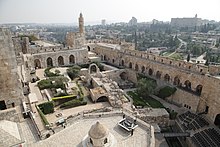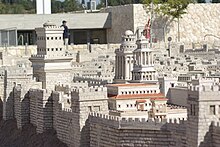Tower of David

The Tower of David (
The citadel that stands today dates to the
Dan Bahat, an Israeli archaeologist, writes that the original three Hasmonean towers standing in this area of the city were altered by Herod, and that "The northeastern tower was replaced by a much larger, more massive tower, dubbed the "Tower of David" beginning in the 5th century C.E."[2] The name "Tower of David" migrated in the 19th century from the Herodian tower in the northeast of the citadel, to the 17th-century minaret at the opposite side of the citadel, and after 1967 has been officially adopted for the entire citadel.[3]
Names
"Tower of David": Herodian tower
The name "Tower of David" was first used for the Herodian tower in the 5th century CE by the Byzantine Christians, who believed the site to be the palace of King David.[2][1] They borrowed the name "Tower of David" from the Song of Songs, attributed to Solomon, King David's son, who wrote: "Thy neck is like the Tower of David built with turrets, whereon there hang a thousand shields, all the armor of the mighty men" (Song of Songs, 4:4).
Arabic names
An Arabic name of the massive Herodian-Mamluk northeast tower is the Burj al-Qalʾa (برج القلعة, 'Citadel Tower').[4]
During the Early Muslim and Ayyubid periods it was known in Arabic as Miḥrāb Dāwūd, lit. 'David's
History


Hasmonean period
During the 2nd century BCE, the
Herod's towers

During the
When the empire adopted Christianity as its favoured religion in the 4th century, a community of monks established itself in the citadel. It was during the Byzantine period that the remaining Herodian tower, and by extension the Citadel as a whole,[dubious ] acquired its alternative name—the Tower of David—after the Byzantines, mistakenly identifying the hill as Mount Zion, presumed it to be David's palace mentioned in 2 Samuel 5:11, 11:1–27, 16:22.
Early Muslims, Crusaders, Ayyubids

After the
During the Crusader period, thousands of pilgrims undertook the pilgrimage to Jerusalem by way of the port at Jaffa. To protect pilgrims from the menace of highway robbers, the Crusaders built a tower surrounded by a moat atop the citadel,[dubious ] and posted lookouts to guard the road to Jaffa.[dubious ] The citadel also protected the newly erected palace of the Crusader kings of Jerusalem, located immediately south of the citadel.[8]
In 1187, Sultan
Mamluk and Ottoman citadel

In 1310 the citadel was rebuilt by Mamluk sultan Al-Nasir Muhammad ibn Qalawun, who gave it much of its present shape.[9]
The citadel was expanded between 1537 and 1541 by the Ottoman sultan Suleiman the Magnificent, whose architects designed a large entrance, behind which stood a cannon emplacement.[dubious ] For 400 years, the citadel served as a garrison for Turkish troops. The Ottomans also installed a mosque near the southwest corner of the citadel commonly known as the Mihrab el-Qal'a ed-Dawood ("Prayer niche of David's fortress"),[10] erecting a minaret during the years 1635–1655. In the 19th century the conspicuous minaret, which still stands today, became commonly referred to as the "Tower of David". At least two mosques are known to exist within the Jerusalem Citadel.[3][11]
During
British and Jordanian periods

During the period of
Following the 1948 Arab–Israeli War, the Arab Legion captured Jerusalem and converted the citadel back to its historical role as a military position, as it commanded a dominant view across the armistice line into Jewish Jerusalem. It would keep this role until 1967.
Tower of David Museum

Since the Six-Day War in 1967, the citadel's cultural role was revived.[clarification needed]
The Tower of David Museum of the History of Jerusalem was opened in 1989 by the Jerusalem Foundation. Located in a series of chambers in the original citadel, the museum includes a courtyard which contains archeological remains dating back 2,700 years.
The exhibits depict 4,000 years of Jerusalem's history, from its beginnings as a
As of 2002, the Jerusalem Foundation reported that over 3.5 million visitors had toured the museum.
Archaeology

This section needs expansion. You can help by adding to it. (April 2019) |
In 2010, a survey of the site was conducted by Yehudah Rapuano on behalf of the Israel Antiquities Authority (IAA).[13]
See also
- Jaffa Gate, the Jerusalem city gate protected by the citadel
- Illés Relief, model of Jerusalem built in 1867–1873
- Tower of David Period, nickname for Jewish art in Palestine during the 1920s
References
- ^ ISBN 978-0-19-923666-4. Retrieved 14 June 2020.
- ^ ISBN 978-1575061429.
- ^ doi:10.5334/pp.25.
- ^ إسرائيل, طاقم تايمز أوف. "مبادرة لتكنولوجيا الواقع الإفتراضي في مختبر الإبتكار الجديد في متحف برج قلعة القدس". تايمز أوف إسرائيل (in Arabic). Retrieved 2020-10-17.
- Mujīrstates that the Miḥrāb in the southern wall of the Ḥaram, near the "Cradle of Jesus", is widely accepted as Miḥrāb Dāwūd.
- C.R. Conder, who held that the "Tower of David" should be identified with the tower of Phasael, based on its size.
- ^ Josephus, The Jewish War (V.IV.3; VII.II.1)
- ^ Gilbert, Martin (1987). Crusader Jerusalem (Map 11) (PDF). Oxford. Archived from the original (PDF) on 14 August 2015. Retrieved 20 October 2015.
{{cite book}}:|work=ignored (help)CS1 maint: location missing publisher (link) - ^ The Citadel: Position, EnjoyJerusalem.com (EU-supported Palestinian website)
- ^ "al-Qal'a Mosque (Masjid Mehrab e Dawud)". Madain Project. Retrieved 14 June 2020.
- ^ "Tower of David Mosques". Madain Project. Retrieved 5 December 2019.
- ^ Tower of David: History of a Citadel, at the homepage (2007) of the Tower of David Museum of the History of Jerusalem Archived 2007-09-05 at the Wayback Machine
- ^ Israel Antiquities Authority, Excavators and Excavations Permit for Year 2010, Survey Permit # A-5826
External links
- 360 degrees HD virtual tour of the Tower of David Museum Archived 2008-01-17 at the Wayback Machine
- Tower of David Museum
- A tourist's guide to the Tower of David Museum Archived 2013-05-09 at the Wayback Machine
Further reading
- For Mihrab Da'ud and Early Muslim traditions regarding David see: Mostafa, Heba (2017-10-08). "From the Dome of the Chain to Miḥrāb Dāʾūd: The Transformation of an Umayyad Commemorative Site at the Haram al-Sharif in Jerusalem". Muqarnas Online. 34 (1): 1–22. JSTOR 26551692.



